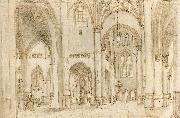La Peinture à l'huile en gros de Chine & Encadre |
|||||||||||

|
|||||||||||
|
|
|
||||||||||||||
|
|
||||||||||||||
|
||||||||||||||
|
|
||||||||||||||
| unknow artist
Interior_of_St_Bavo_s_Church_in_Haarlem 1628 Paper, 174 x 263 mm Musees Royaux des Beaux-Arts, Brussels Pieter Jansz. Saenredam was born in Assendelft in 1597, the son of Jan Saenredam, a respected engraver who worked, among others, for Hendrick Goltzius. From the outset of his career Saenredam devoted almost his entire energy to depicting existing buildings, mainly churches and city halls. Only occasionally did he leave the city of Haarlem to go and paint in other Dutch cities. At his death in 1665 he was seen as the Netherlands' first architecture specialist. With unusual precision he prepared each canvas by what was then a totally new method. In each case he started from sketches made in situ, as the present drawing, which shows the transept and a part of the choir of the late Gothic church of St Bavo. After this he took measurements of the building or, as in this case, consulted a list of basic measurements. Using this material and with the help of perspective techniques specific to surveyors and architects, he then developed a construction drawing in his studio. This drawing had the same measurements as the final painting and was scored onto the prepared panel. In the present case, the corresponding painting is to be found in the Paul Getty Museum, Malibu. The lines are sketched in rather than drawn, giving a looser and more spontaneous impression than his later, somewhat stiffer hand. Even so the drawing already possesses the impressive poetic power of Saenredam's full-grown style. He sought not to provide an anecdotal description of the church, but rather to give a suggestion of its absolutely pure space. This interior with its sober, bare walls expresses a refined distinction. This is supported in an unequalled manner by the equally pure means of representation: a soft grey wash over fragile pen lines. In this way the church seems to be filled with a subdued light that binds objects together with a series of intangible gradations from light to dark. One striking fact is that the south transept gives access through three open doors into the street, whereas the transept in fact ended in a closed doorway. This demonstrates the genius with which Saenredam made his quest for topographical exactitude subservient to the demands of an attractive composition and a lively "mise en scene". , Artist: SAENREDAM, Pieter Jansz , Interior of St Bavo's Church in Haarlem , 1601-1650 , Dutch , graphics , interior 1628 Paper, 174 x 263 mm Musees Royaux des Beaux-Arts, Brussels Pieter Jansz. Saenredam was born in Assendelft in 1597, the son of Jan Saenredam, a respected engraver who worked, among others, for Hendrick Goltzius. From the outset of his career Saenredam devoted almost his entire energy to depicting existing buildings, mainly churches and city halls. Only occasionally did he leave the city of Haarlem to go and paint in other Dutch cities. At his death in 1665 he was seen as the Netherlands' first architecture specialist. With unusual precision he prepared each canvas by what was then a totally new method. In each case he started from sketches made in situ, as the present drawing, which shows the transept and a part of the choir of the late Gothic church of St Bavo. After this he took measurements of the building or, as in this case, consulted a list of basic measurements. Using this material and with the help of perspective techniques specific to surveyors and architects, he then developed a construction drawing in his studio. This drawing had the same measurements as the final painting and was scored onto the prepared panel. In the present case, the corresponding painting is to be found in the Paul Getty Museum, Malibu. The lines are sketched in rather than drawn, giving a looser and more spontaneous impression than his later, somewhat stiffer hand. Even so the drawing already possesses the impressive poetic power of Saenredam's full-grown style. He sought not to provide an anecdotal description of the church, but rather to give a suggestion of its absolutely pure space. This interior with its sober, bare walls expresses a refined distinction. This is supported in an unequalled manner by the equally pure means of representation: a soft grey wash over fragile pen lines. In this way the church seems to be filled with a subdued light that binds objects together with a series of intangible gradations from light to dark. One striking fact is that the south transept gives access through three open doors into the street, whereas the transept in fact ended in a closed doorway. This demonstrates the genius with which Saenredam made his quest for topographical exactitude subservient to the demands of an attractive composition and a lively "mise en scene". , Artist: SAENREDAM, Pieter Jansz , Interior of St Bavo's Church in Haarlem , 1601-1650 , Dutch , graphics , interior |
||||||||||||||
|
Related Paintings to unknow artist :. |
||||||||||||||
|
|
||||||||||||||
|
|
||||||||||||||
|
CONTACTER DES Etats-Unis |







